Dogs
Gentle Companions: Least Aggressive Dog Breeds
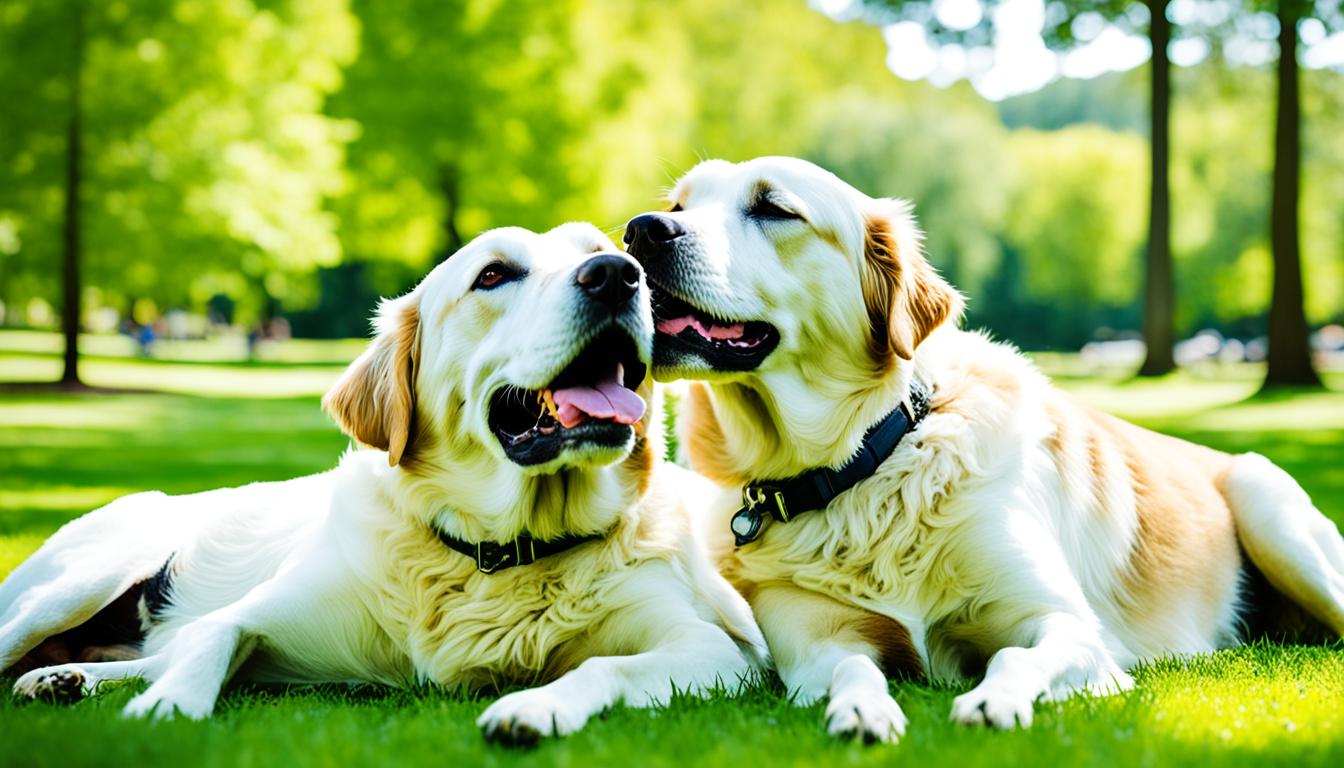
Did you know that certain dog breeds have a natural inclination towards gentleness and are known to be the least aggressive? If you’re looking for a furry friend who will provide love, companionship, and a peaceful environment, these breeds are perfect for you. In this article, we will explore the wonderful world of the least aggressive dog breeds and highlight their temperament, characteristics, and suitability as family pets.
Key Takeaways
- Choosing a non-aggressive dog breed can create a peaceful and loving environment in your home.
- Gentle dog breeds are known for their calm, amiable, and approachable personalities.
- The ease of training and adaptability of non-aggressive breeds make them great choices for families.
- Non-aggressive dogs prioritize the safety of their owners, leading to fewer incidents of aggression.
- Owning a non-aggressive breed can help you avoid legal hassles associated with owning aggressive dogs.
Understanding Dog Aggression
Dog aggression is a complex behavior that can stem from a variety of factors. It’s important to differentiate between aggressive behaviors and reactive behaviors that are a response to environmental stimuli. In this section, we will delve into the different types of aggression in dogs and explore the causes behind their aggressive tendencies.
Types of Dog Aggression
There are several distinct types of dog aggression that owners may encounter:
- Territorial aggression: Dogs may display aggression to protect their perceived territory, such as their home or backyard.
- Protective aggression: Dogs may exhibit protective behaviors towards their owners, family members, or possessions.
- Fear aggression: Dogs who are fearful may display aggression as a defense mechanism.
- Redirected aggression: Dogs may redirect their aggression towards another target when their initial target is inaccessible.
By understanding the different types of aggression, owners can identify the underlying causes and find appropriate behavioral interventions.
Causes of Aggression in Dogs
Aggression in dogs can arise from various factors, including:
- Genetic predisposition: Certain breeds may have a higher likelihood of exhibiting aggressive behaviors due to their genetic background.
- Environmental factors: Poor socialization, traumatic experiences, or abusive treatment can contribute to the development of aggression.
- Medical issues: Pain or discomfort caused by underlying health conditions can lead to aggression in dogs.
It’s crucial to consult with a professional veterinarian or animal behaviorist to determine the root causes of aggression in dogs and establish an appropriate treatment plan.
“Understanding the causes and types of dog aggression enables owners to address the issue effectively and promote a harmonious relationship with their furry companions.”
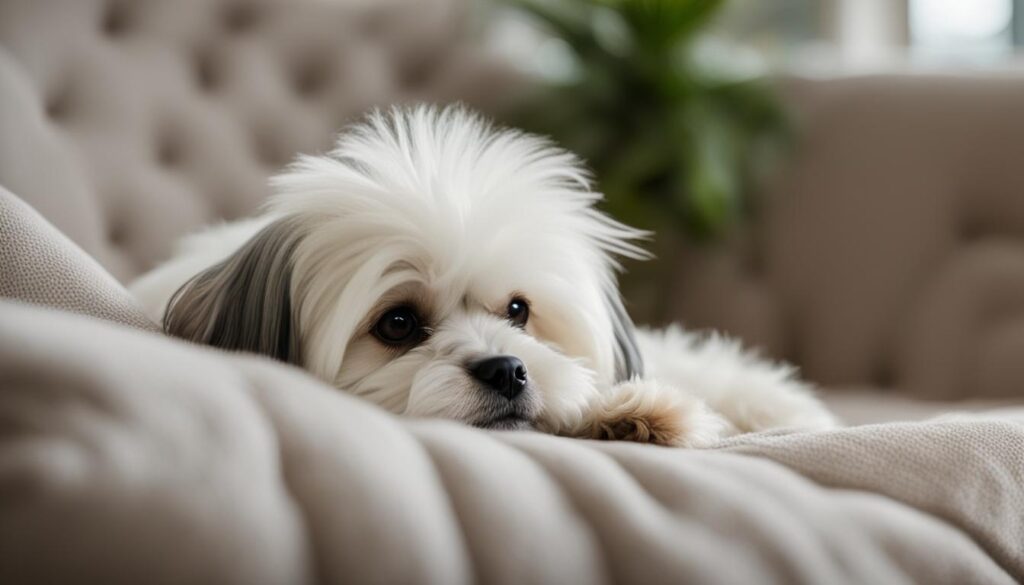
| Type of Aggression | Causes |
|---|---|
| Territorial aggression | Perceived threat to territory |
| Protective aggression | Desire to protect owners or possessions |
| Fear aggression | Response to fear or perceived threats |
| Redirected aggression | Instigating aggression towards a different target |
What Are The Criteria for Non-Aggressive Breeds?
When choosing a non-aggressive dog breed, several criteria should be considered. These factors play a significant role in determining a breed’s temperament, social behavior, and training ease. By understanding these criteria, you can make an informed decision and find a dog that fits well with your lifestyle and preferences.
Temperament
The temperament of a dog breed is crucial when considering their level of aggression. Non-aggressive breeds typically have calm, amiable, and approachable personalities. They are known for their gentle nature and ability to get along well with other animals and people. These breeds are less likely to display aggressive behaviors when faced with challenging situations.
Socialization
Socialization plays an important role in determining a dog’s aggression levels. Breeds that are naturally sociable tend to be less aggressive. Through proper socialization during their early years, dogs learn how to interact with different people, animals, and environments. This exposure helps them develop the necessary social skills and reduces the likelihood of aggressive behavior later in life.
Training Ease
The ease of training is another key factor to consider when choosing a non-aggressive breed. Non-aggressive breeds are typically intelligent, adaptable, and quick learners. They are more willing to follow commands and are eager to please their owners. With consistent training and positive reinforcement, these breeds can easily learn and understand desired behaviors, reducing the likelihood of aggressive tendencies.
Dog Size
The size of the dog can also contribute to their level of aggression. Generally, larger or medium-sized breeds tend to be more laid-back and less prone to aggressive behavior compared to smaller breeds. However, it is important to note that aggression is not solely determined by size, and individual temperament should always be considered.
“When choosing a non-aggressive breed, assessing their temperament, socialization, training ease, and size can help you find a dog that will be a gentle and loving companion for you and your family.”
To provide a better understanding, here is a table summarizing the criteria for non-aggressive dog breeds:
| Criteria | Description |
|---|---|
| Temperament | Calm, amiable, and approachable personalities |
| Socialization | Naturally sociable and well-socialized |
| Training Ease | Intelligent, adaptable, and quick learners |
| Dog Size | Larger or medium-sized breeds are generally more laid-back |
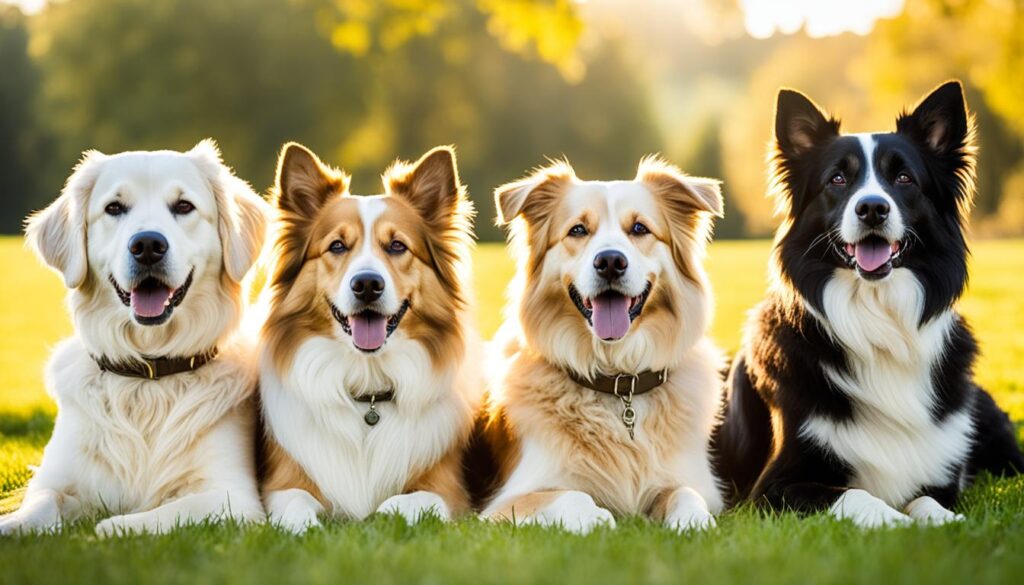
By considering these criteria when selecting a dog breed, you can increase the chances of finding a non-aggressive companion that will bring joy and harmony to your home.
Why Choose a Non-Aggressive Dog Breed?
Non-aggressive dog breeds offer several benefits to their owners. Their calm and gentle nature creates a peaceful environment in the home, allowing for a harmonious companionship.
These breeds also require less training compared to aggressive dogs, as they have a lower level of pent-up energy and aggression. With non-aggressive dogs, you can spend less time and effort on extensive training sessions and more time enjoying their company.
“Non-aggressive dogs prioritize the safety of their owners and are less likely to exhibit aggressive behaviors.” – Dr. Emily Thompson, Animal Behavior Specialist
Choosing a non-aggressive breed ensures the safety of your family and visitors. Unlike aggressive breeds, non-aggressive dogs are not prone to sudden outbursts or unpredictable behaviors. You can have peace of mind knowing that your furry companion will not pose a threat to others.
Additionally, owning a non-aggressive dog can help you avoid legal hassles. Aggressive dogs may be subject to breed-specific legislation and restrictions, which could result in added legal responsibilities and potential liability. By choosing a non-aggressive breed, you can enjoy the companionship of a loving pet without worrying about legal complications.
The Benefits of Non-Aggressive Dogs:
| Benefits | Description |
|---|---|
| Peaceful Environment | Non-aggressive dogs create a peaceful atmosphere at home, promoting a sense of tranquility and harmony. |
| Less Training Required | Non-aggressive breeds have a lower level of pent-up energy and aggression, resulting in reduced training needs. |
| Assured Safety | Non-aggressive dogs prioritize the safety of their owners and are less likely to exhibit aggressive behaviors. |
| No Legal Hassles | Choosing a non-aggressive breed can help avoid legal complications associated with owning aggressive dogs. |
Top 5 Non-Aggressive Dog Breeds
When it comes to finding a gentle and non-aggressive companion for your family, certain dog breeds stand out for their friendly and sociable nature. These breeds are known for their temperament, loyalty, and adaptability, making them perfect additions to any household. Here are the top 5 non-aggressive dog breeds to consider:
1. Golden Retriever
The Golden Retriever is a beloved family dog known for its friendly and sociable nature. These dogs are not only gentle but also highly intelligent and eager to please, making them excellent family companions. With their loyalty and gentle disposition, Golden Retrievers often form deep bonds with their human family members.
2. Labrador Retriever
Labrador Retrievers are energetic, playful, and gentle, making them popular choices for families. These friendly and outgoing dogs excel in social situations and can get along well with people of all ages, including children. Their intelligence and trainability add to their appeal as family pets.
3. Basset Hound
Basset Hounds have a calm and easy-going demeanor that makes them highly suitable for families and seniors. These dogs are known for their friendly nature and patience. Despite their droopy ears and sad eyes, Basset Hounds are cheerful and devoted companions.
4. Bernese Mountain Dog
Bernese Mountain Dogs are gentle giants known for their patience and loyalty. These large and friendly dogs are great with children and can adapt well to various living environments. Bernese Mountain Dogs are not only gentle in nature but also excellent watchdogs, making them perfect for families seeking both companionship and security.
5. Beagle
Beagles are social, intelligent, and friendly dogs that make wonderful family pets. Their loving and gentle disposition, combined with their high adaptability, makes them a popular choice for families with children. Beagles enjoy human companionship and thrive in an active and loving environment.
These top 5 non-aggressive dog breeds offer a combination of gentleness, loyalty, and adaptability that make them perfect companions for families. Whether you’re looking for a playful and energetic dog like the Labrador Retriever or a calm and easy-going companion like the Basset Hound, there is a non-aggressive breed out there to suit your family’s needs.
Top 5 Non-Aggressive Dog Breeds (Continued)
In the previous section, we explored some of the gentlest dog breeds. Now, let’s continue our journey and discover five more non-aggressive breeds that make excellent companions.
Bulldog
Despite their muscular build and imposing appearance, Bulldogs are known for their sweet and adaptable nature. They are a popular choice for families and individuals seeking a loyal and affectionate companion. Bulldogs are great with children and have a calm demeanor, making them a wonderful addition to any household.
Newfoundland Dog
Considered one of the gentlest and most protective breeds, Newfoundland Dogs are known for their immense size and loving nature. These gentle giants are highly trainable and have a natural instinct to care for their family. Whether it’s playing with children or being a comforting presence, Newfoundland Dogs bring joy and affection to their owners.
Greyhound
Greyhounds are often associated with speed and agility, but they are also known for their calm and laid-back temperament. These couch potatoes enjoy a peaceful environment and make great companions for those seeking a relaxed and low-energy dog. Despite their racing background, Greyhounds are docile and love nothing more than lounging on the sofa with their owners.
Boxer
Boxers are known for their fun-loving and loyal nature. These energetic dogs are easily adaptable to various situations and are great with families. Boxers are highly sociable and thrive on human companionship. Their playful demeanor and unwavering loyalty make them cherished members of the family.
Cavalier King Charles Spaniel
Cavalier King Charles Spaniels are small to medium-sized dogs with a sweet disposition and an adaptable nature. These dogs are known for their friendly and affectionate personality, making them an ideal choice for families and individuals alike. Cavalier King Charles Spaniels get along well with children and other pets, bringing joy and companionship to their owners’ lives.
Each of these non-aggressive breeds offers a unique set of qualities, ensuring a loving and peaceful companionship. Whether you’re looking for a confident Bulldog, a protective Newfoundland Dog, a calm Greyhound, a loyal Boxer, or a friendly Cavalier King Charles Spaniel, one of these breeds is sure to steal your heart.
| Breed | Description |
|---|---|
| Bulldog | A muscular and robust breed with a sweet and adaptable nature. |
| Newfoundland Dog | A gentle giant known for its immense size, protectiveness, and loving nature. |
| Greyhound | A calm and laid-back breed that enjoys a peaceful environment. |
| Boxer | A fun-loving and loyal breed that easily adapts to various situations. |
| Cavalier King Charles Spaniel | A small to medium-sized dog with a sweet disposition and an adaptable nature. |
These non-aggressive breeds prove that size, appearance, and stereotypes can be misleading. Each one offers a unique combination of traits that make them wonderful companions for individuals and families alike.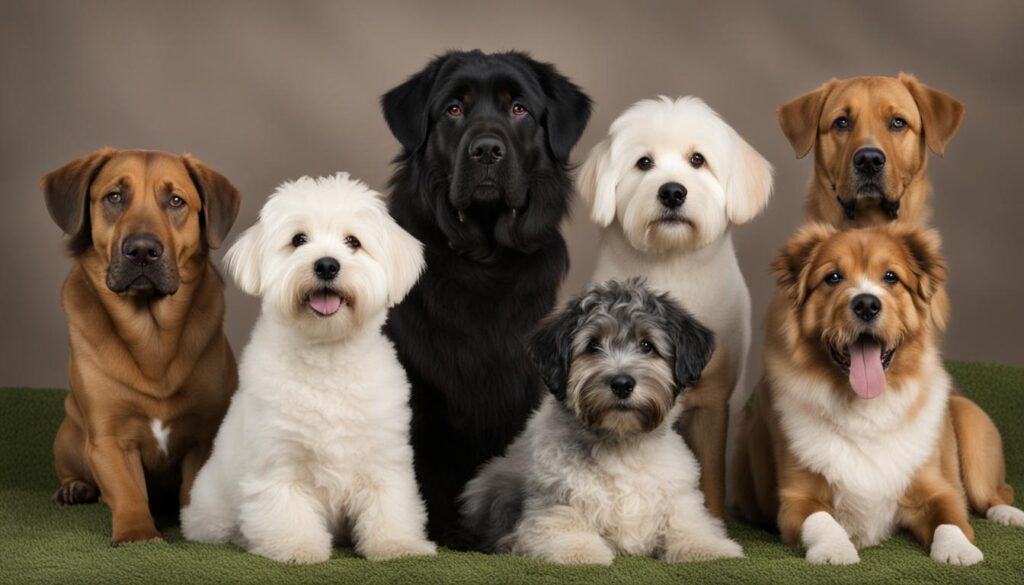
Top 5 Non-Aggressive Dog Breeds (Continued)
Continuing our exploration of non-aggressive dog breeds, let’s discover five more gentle and amiable companions that will bring joy and warmth to your home.
Pug
The Pug is a small, affectionate, and sociable breed known for its easy-going nature. With their wrinkled faces, expressive eyes, and playful personality, Pugs make wonderful family pets. They are social creatures that get along well with children and other animals, making them a delightful addition to any household.
Irish Setter
Irish Setters are known for their vibrant red coat, friendly nature, and love for outdoor activities. They are fun-loving, kind, and thrive on human companionship. Irish Setters are highly sociable and make excellent playmates for children. With their joyful disposition and eagerness to please, they bring happiness and laughter wherever they go.
Whippet
Descended from Greyhounds, Whippets are the epitome of grace and charm. These gentle and friendly dogs are known for their calm and laid-back temperament. Whippets are ideal companions for individuals or families seeking a quiet and well-mannered pet. They are content to curl up on the couch with you or accompany you on leisurely walks.
St. Bernard
The St. Bernard is a calm and relaxed gentle giant that often takes on the role of a “nanny dog” due to their gentle nature around children. Despite their massive size, St. Bernards are incredibly patient, loving, and devoted to their families. They are excellent therapy dogs and provide comfort and support to those in need.
Bichon Frise
Bichon Frises are small dogs with a friendly, easy-going, and sociable disposition. They are known for their cheerful nature and make great companions for families, seniors, and singles alike. Bichon Frises thrive on human interaction and enjoy participating in various activities, making them a delightful addition to any household.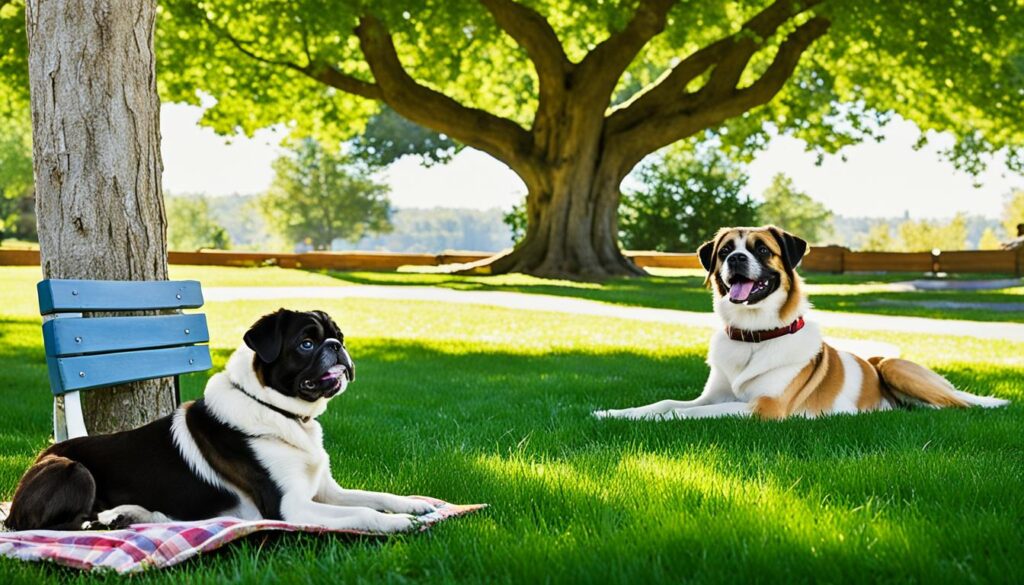
These non-aggressive dog breeds, including the Pug, Irish Setter, Whippet, St. Bernard, and Bichon Frise, exemplify the gentle and loving qualities that many families desire in their canine companions. Whether you prefer a small or large breed, there is a non-aggressive dog waiting to bring happiness and unconditional love into your life.
Conclusion
Choosing a non-aggressive dog breed is a great way to ensure a peaceful and loving pet. These least aggressive dog breeds make wonderful companions for families seeking gentle and friendly pets. From Golden Retrievers and Labrador Retrievers to Basset Hounds and Bernese Mountain Dogs, there is a wide variety of breeds to choose from. Bulldogs, Greyhounds, Boxers, and Cavalier King Charles Spaniels also make excellent non-aggressive pets. Whether you prefer a large or small breed, there is a gentle companion out there for everyone.
By welcoming one of these peaceful pets into your home, you can enjoy their affectionate and sociable nature. These dogs will become cherished members of your family, providing you with companionship and love. Revel in the peaceful and loving presence of these least aggressive dog breeds, knowing that you have chosen a gentle companion who will bring joy to your life.
So, if you’re considering adding a new furry friend to your family, look no further than these least aggressive dog breeds. With their calm temperament and gentle nature, they will create a tranquil and harmonious environment in your home. Choose one of these peaceful pets and experience the joys of having a loving and loyal companion by your side.FAQ
What are the least aggressive dog breeds?
What factors contribute to dog aggression?
What criteria should be considered when choosing a non-aggressive dog breed?
What are the benefits of owning a non-aggressive dog breed?
Dana is our Lead Content Writer, bringing a wealth of knowledge and expertise to our team. With a background deeply rooted in animal studies and a profound love for all creatures, Dana is dedicated to crafting engaging and informative content that resonates with our audience. With Dana at the helm, you can trust that our content is accurate and engaging, catering to the diverse interests of animal enthusiasts everywhere.
Dogs
Unique J.R.R. Tolkien Cat Names
Discover unique J.R.R. Tolkien cat names starting with the letter 'P', each holding a mysterious and enchanting allure for your feline companion.
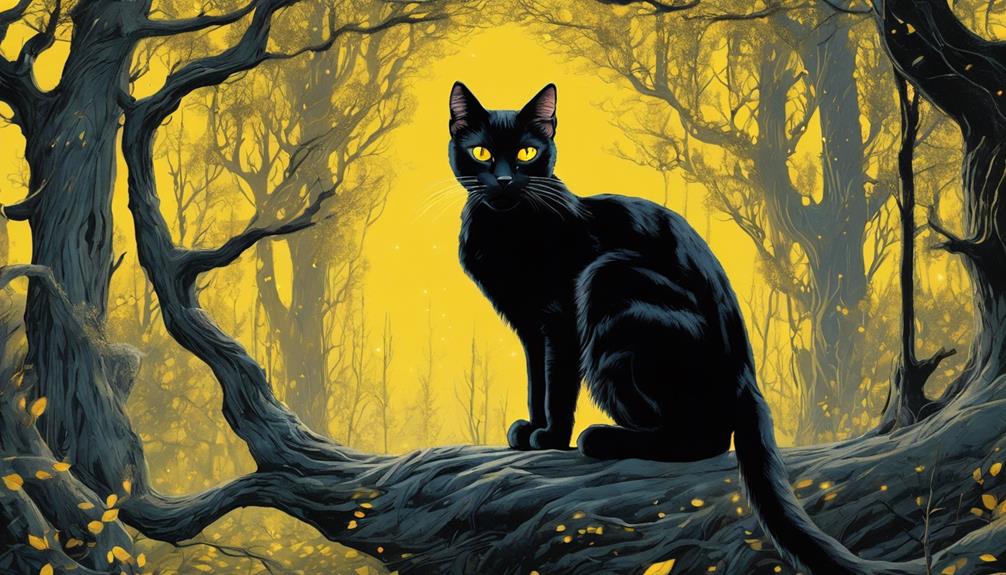
When searching for unique J.R.R. Tolkien cat names, consider iconic characters like Frodo, Gandalf, Arwen, or Legolas for traits of bravery, wisdom, grace, and skill. Explore mystical domains such as Rivendell, Lothlórien, Mordor, or Rohan, each embodying different essences from Middle-earth. Discover artifact-inspired names like One Ring, Sting, or Andúril, each with a tale from Tolkien's mythos. Reflect admirable qualities with names like Noble, Wise, Curious, Resilient, or Brave to deepen your bond with your pet. Embrace names like Sauron, Sam, Merry, or Legolas to infuse a touch of Tolkien's mythical world. Uncover more enchanting options within Tolkien's domain.
Key Takeaways
- Iconic Character Cat Names inspired by Tolkien's characters.
- Mystical Locale Cat Names reflecting Middle-earth's essence.
- Artifact-Inspired Cat Names embodying Tolkien's mythology.
- Qualities-Inspired Cat Names celebrating heroic virtues.
- Mythical Nature Cat Names inspired by Tolkien's mythical world.
Iconic Character Cat Names
When choosing unique cat names inspired by J.R.R. Tolkien's iconic characters, we can draw inspiration from the courageous and mystical beings that populate Middle-earth. Frodo, a name evoking bravery and resilience, could suit a cat with a bold spirit. Gandalf, symbolizing wisdom and guidance, might be perfect for a feline companion who exudes intelligence. Arwen, reflecting grace and sacrifice, could be a fitting choice for a gentle and loving cat. Legolas, representing agility and skill, could be ideal for a nimble and playful kitty.
Each of these names carries a rich history and deep meaning, adding a touch of magic and mystique to your cat's identity. Whether your feline friend embodies the adventurous spirit of Frodo, the wise demeanor of Gandalf, the loving nature of Arwen, or the agile movements of Legolas, choosing a name inspired by these iconic Tolkien characters can bring an extra layer of enchantment to your bond with your cat.
Mystical Locale Cat Names
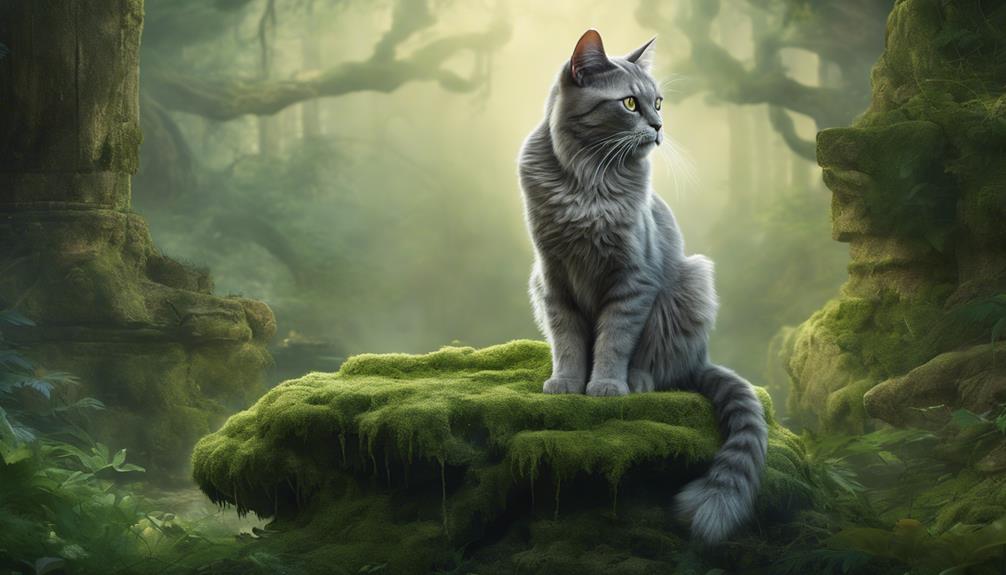
Let's explore enchanting options for cat names inspired by mystical locales in J.R.R. Tolkien's Middle-earth.
For a feline companion exuding peace and wisdom, 'Rivendell' could be a perfect fit, paying homage to the tranquil elven haven where the Fellowship sought respite and counsel.
If you seek a name that captures beauty and magic, 'Lothlórien' might be ideal, reminiscent of the enchanted forest dominion ruled by Galadriel and Celeborn.
However, for a cat with a mysterious and dark allure, 'Mordor' could be a striking choice, reflecting the desolate land where Mount Doom harbored the One Ring's fiery forge.
On the other hand, if your furry friend embodies strength and nobility, 'Rohan' could be a fitting option, symbolizing the domain of the horse-lords known for their vast grasslands and skilled cavalry.
Each of these names carries a unique essence inspired by the mystical locales of Middle-earth, adding a touch of magic to your feline companion's identity.
Artifact-Inspired Cat Names
Inspiring feline names can be drawn from powerful artifacts in J.R.R. Tolkien's Middle-earth, each imbued with significant meaning and lore. For cat names inspired by rings, consider naming your furry friend after the 'One Ring,' a symbol of power and corruption sought by Sauron to dominate Middle-earth. Another option could be 'Sting,' the glowing sword wielded by Bilbo and Frodo that warns of the presence of orcs and goblins. If you seek a regal name for your cat, 'Andúril' might be a fitting choice, symbolizing Aragorn's rightful claim to the throne as the reforged sword of kings.
Each of these artifact-inspired cat names carries a unique story and essence from Tolkien's rich mythology. Whether you choose a name like the One Ring for a mischievous cat, Sting for a vigilant and adventurous feline, or Andúril for a majestic and noble companion, your cat will surely embody the spirit of these iconic artifacts from Middle-earth.
Qualities-Inspired Cat Names
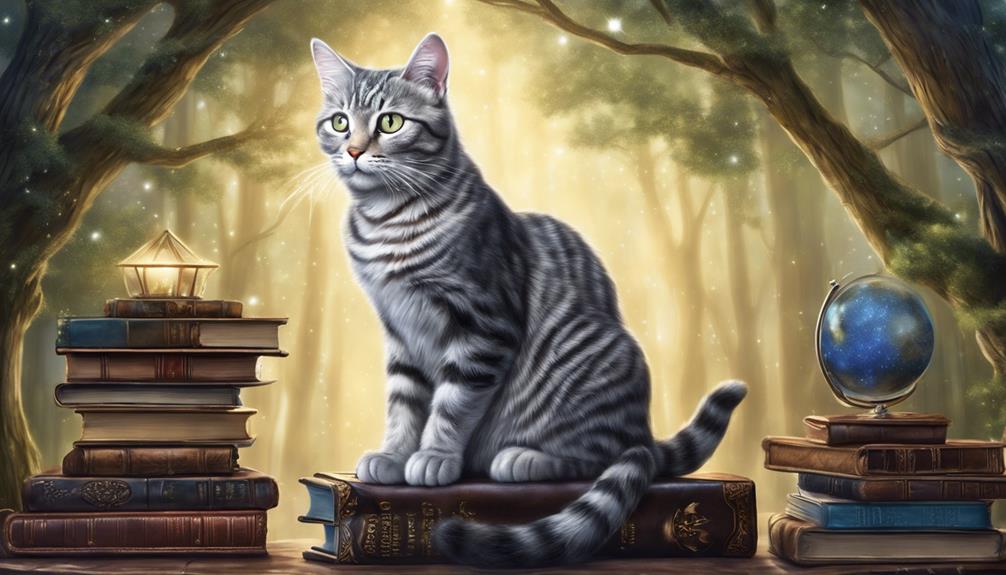
Drawing inspiration from the admirable and heroic qualities depicted in J.R.R. Tolkien's works, consider naming your feline companion after virtues like 'Noble,' 'Wise,' 'Curious,' 'Resilient,' or 'Brave.' These qualities aren't only celebrated in the legendary characters of Middle Earth but also serve as a reminder of the values and traits upheld in Tolkien's masterpieces. By choosing qualities-inspired names for your cat, you can infuse depth and significance into the bond between you and your pet, reflecting the essence of Tolkien's storytelling.
Imagine calling your cat 'Noble,' embodying the dignity and honor found in characters like Aragorn or Galadriel. 'Wise' could be a fitting name for a clever and perceptive feline reminiscent of Gandalf. 'Curious' might suit a playful and inquisitive cat akin to the Hobbits exploring the Shire. 'Resilient' could be perfect for a tough and enduring companion inspired by the perseverance of Frodo. 'Brave' encapsulates the courage and valor seen in heroes like Samwise Gamgee. Choose a name that not only sounds delightful but also encapsulates the essence of the qualities you admire in Tolkien's rich tapestry of characters.
Mythical Nature Cat Names
Mythical nature cat names from J.R.R. Tolkien's works offer a blend of mystique and character for feline companions.
Sauron, a dark and powerful antagonist, lends an air of mystery and strength to your cat's persona.
Sam, embodying loyalty and bravery as a hobbit companion, provides a name full of courage and steadfastness for your furry friend.
Merry, with his cheerful and mischievous nature, offers a whimsical option that captures the playful essence of a cat.
Legolas, the skilled elven archer deeply connected to nature, bestows a name that reflects grace and agility upon your feline companion.
Each name brings a unique element inspired by Tolkien's mythical world, allowing your cat to embody traits that resonate with these iconic characters like Sauron's power, Sam's loyalty, Merry's cheer, and Legolas' connection to nature.
Choosing one of these mythical nature cat names can add a touch of magic to your feline companion's identity.
Frequently Asked Questions
What Is the Rarest Cat Name?
The rarest cat name reflects individuality and creativity. It embodies a distinctive charm that sets your feline companion apart. Discovering such a name requires thoughtfulness and a deep connection to your pet's essence.
What Is the Genius Name for Cats?
We believe the genius name for cats is one that captures their unique essence. Names like Gandalf, Arwen, Frodo, Legolas, and Sam from J.R.R. Tolkien's world offer depth and magic to our feline friends.
What Is the Name of the Royal Cat?
The name of the royal cat is Tevildo, Prince of Cats. Initially a malevolent character causing trouble for Beren and Lúthien, Tevildo eventually transformed into Sauron, showcasing Tolkien's evolving world-building in his legendarium.
Are There Any Cats in Lotr?
No, there aren't any cats in Lotr. Tolkien's world is rich with creatures, but feline friends are absent. Fans seeking Tolkien-inspired cat names will need to think beyond his works' pages.
Conclusion
To summarize, selecting a unique J.R.R. Tolkien-inspired name for your cat can infuse a sense of enchantment and playfulness into your furry companion's identity. Whether you decide on a renowned character name, a mystical place name, or a traits-inspired name, there are numerous choices available.
By thoughtfully picking a name that resonates with Tolkien's vivid imagination, you can bestow upon your cat a distinctive and unforgettable title that embodies the magical realm of Middle-earth. Choose wisely, and may your cat's name bring delight and awe to your household.
As our Editor-in-Chief, James plays a pivotal role in ensuring the quality and integrity of our content. With a keen eye for detail and a passion for storytelling, James oversees the editorial process here at A Place for Animals. With years of experience in content editing, James ensures that every piece of content meets our high standards of accuracy and clarity. Under James’ guidance, you can rest assured that the content you read is informative and impeccably crafted.
Dogs
Top 5 Cinderella-Inspired Cat Names for Royal Pets
Step into a world of enchantment with the top 5 Cinderella-inspired cat names starting with the letter 'S', fit for royal feline companions!
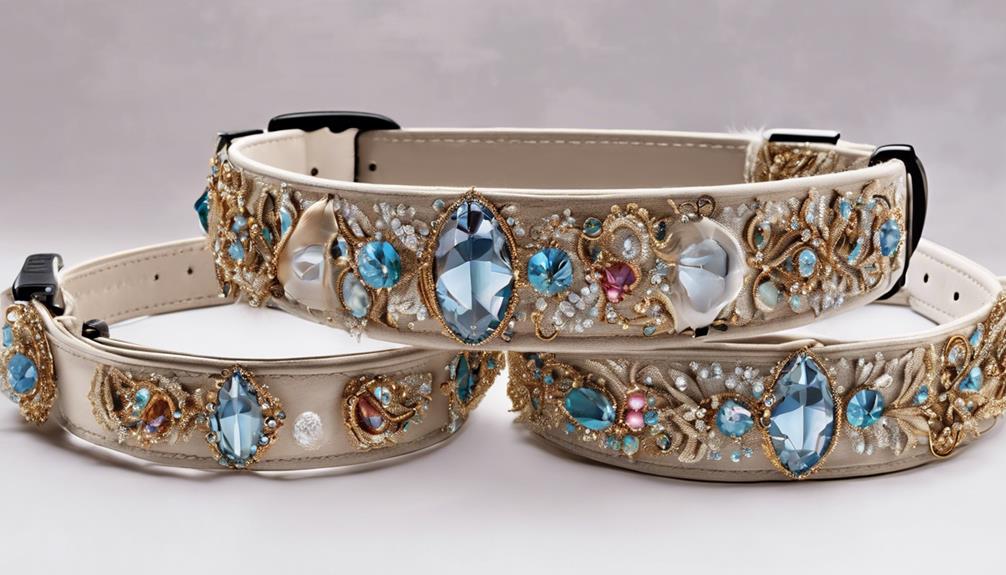
When considering names for royal feline companions inspired by Cinderella, the top five choices include Cinder, Ella, Prince Charming, Fairy Godmother, and Glass Slipper. Each name embodies regal grace, elegance, and a touch of fairy tale charm, reflecting enchantment and sophistication. Cinder symbolizes a transformative journey, Ella defines grace and elegance, Prince Charming exudes gallantry and sophistication, Fairy Godmother adds a magical touch, and Glass Slipper represents destiny fulfilled through love. These names bring a regal aura to your cat's identity, signaling nobility and charm. A royal touch awaits your feline friend with these Cinderella-inspired names!
Key Takeaways
- Cinder: embodies regal grace and charm, inspired by Cinderella's tale.
- Ella: defines grace and elegance, perfect for princess-like cats.
- Prince Charming: exudes nobility and charm, ideal for a dashing cat.
- Fairy Godmother: adds whimsy and enchantment, capturing a magical essence.
- Glass Slipper: symbolizes elegance and destiny, perfect for white cats with poise.
Cinder – A Name Fit for Royalty
Elegantly embodying regal grace and charm, our feline companion can aptly be deemed Cinder – a name inspired by the enchanting tale of Cinderella. When considering royal cat names, Cinder stands out as a classic choice that exudes fairy tale charm. This name not only pays homage to the iconic glass slipper but also symbolizes the transformative journey from rags to riches, mirroring Cinderella's story.
Choosing Cinder as a cat name for your royal pet brings a touch of magic and fantasy into your home. The name carries a sense of elegance and sophistication, fitting for a regal feline friend. Just like Cinderella captivated hearts with her grace and charm, your cat named Cinder can enchant all who encounter them. Embracing this timeless and classic name adds a touch of whimsy and enchantment to your furry companion, making them truly stand out as royalty among pets.
Ella – Graceful and Elegant Choice
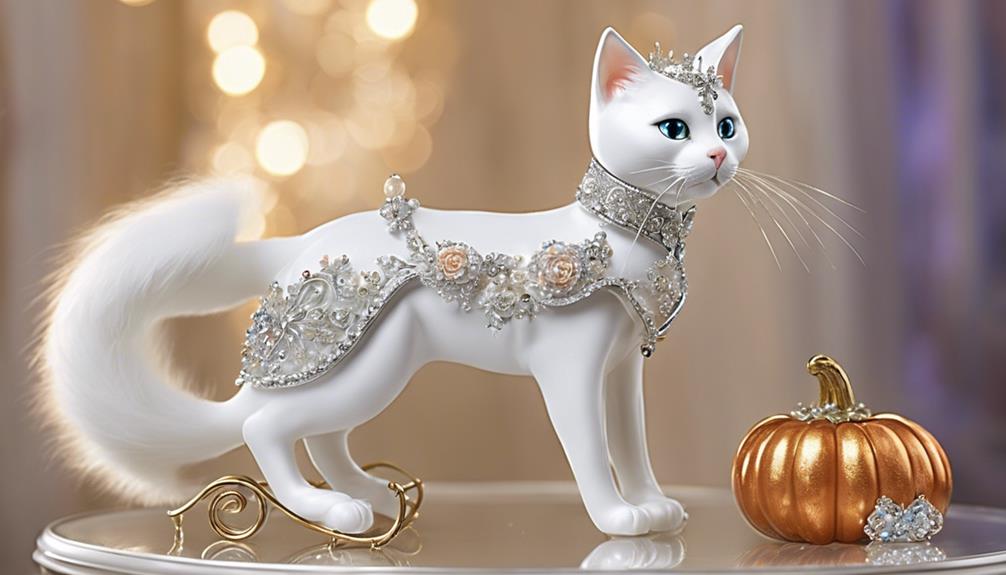
Grace and elegance define 'Ella' as a timeless and charming choice for your royal feline companion. This name exudes a sense of royalty and sophistication, perfect for a princess-like cat that embodies grace and elegance in every movement.
Just like Cinderella, 'Ella' is a name that resonates with a regal aura, making it an ideal pick for cat owners seeking a touch of fairy tale magic in their pet's identity. The simplicity and beauty of 'Ella' encapsulate the essence of a graceful and elegant companion, reflecting the poise and charm befitting a royal cat.
Choosing 'Ella' for your feline friend not only honors the beloved princess but also adds a sense of refinement and sophistication to their character. Embrace the royal heritage and noble qualities that 'Ella' brings, elevating your cat's status to that of a true princess in your household.
Prince Charming – Perfect for a Dashing Cat
A cat named Prince Charming embodies a regal and dashing presence that captures the essence of nobility and grace. This royal kitty exudes charm and elegance, making it a perfect choice for feline companions who deserve a name that reflects their majestic nature.
Prince Charming isn't just a name; it symbolizes the virtues of gallantry and sophistication, aligning perfectly with the image of a cat with a princely demeanor. The significance of the name goes beyond mere words; it signifies nobility and grace, just like a crown adorning the head of a king.
Choosing Prince Charming as the moniker for your furry friend adds a touch of fairy tale magic to their identity, elevating them to a level of enchantment and regality that suits their distinguished character. So, if you seek a name that conveys both elegance and nobility, consider Prince Charming for your beloved feline companion.
Fairy Godmother – Adding a Magical Touch
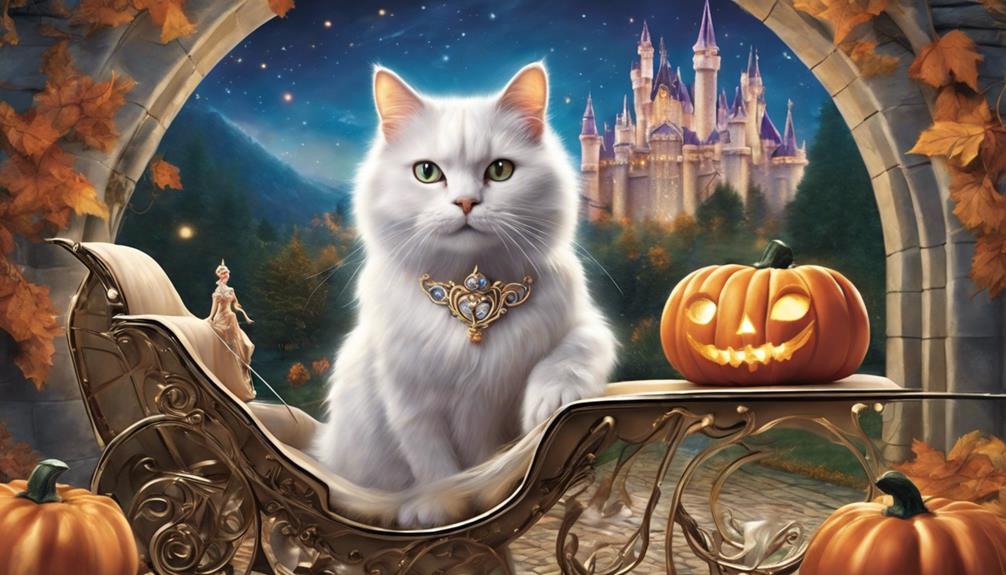
Embracing the enchanting allure of a magical touch, a Fairy Godmother-inspired name for your feline companion can infuse their persona with whimsy and charm.
The Fairy Godmother, known for her transformative magic in the Cinderella story, brings a sense of enchantment to any royal pet lucky enough to bear her name. Names like 'Fae' or 'Glimmer' capture the mystical essence associated with the fairy godmother, adding a touch of fantasy to your cat's identity.
Imagine your regal pet embodying the same spellbinding abilities as the enchanting Fairy Godmother. Choosing a name like 'Enchanta' or 'Charisma' can evoke the transformative magic she wields, creating a sense of wonder and elegance around your furry friend.
Glass Slipper – Symbol of Elegance
Infusing your feline companion's persona with elegance and charm, the Glass Slipper serves as a symbolic representation of grace and enchantment in the Cinderella story. This magical shoe, with its ability to fit only Cinderella's foot, signifies not just a perfect fit but also destiny fulfilled through love.
For a white cat exuding regal poise and sophistication, 'Glass Slipper' could be the perfect name, embodying the essence of royalty and elegance. Just like in the fairy tale, where the glass slipper is the key to identifying Cinderella as the true princess, naming your royal pet after this iconic symbol means capturing the enchanting and magical aura of the Cinderella tale.
The Glass Slipper symbolizes the transformative power of love and destiny, making it an ideal choice for a cat that exudes grace and charm. So, if you have a white cat that embodies elegance, consider 'Glass Slipper' as the perfect regal name.
Frequently Asked Questions
What Is a Royal Name for a Cat?
We believe a royal name for a cat embodies elegance and nobility, often inspired by monarchs, historical figures, or fictional characters. Such names add sophistication to a pet's identity, creating a regal aura.
What Cats Are Royal?
We believe that various cat breeds can be considered royal based on their regal appearance, demeanor, or historical associations. Some feline companions of monarchs or nobles receive special treatment, titles, and roles in royal households.
What Disney Name Should I Name My Cat?
We should name our cat after a beloved Disney character! It's a tough decision, but Cinderella, Gus-Gus, Anastasia, Jaq, or Fairy Godmother are all enchanting choices for our royal feline friend.
What Are Disney Cats Called?
We call them Disney cats, those charismatic felines that weave mischief and charm into our beloved stories. Whether heroes or villains, they captivate us with their antics, adding depth and whimsy to the tales we adore.
Conclusion
So there you have it, the top 5 Cinderella-inspired cat names fit for your royal feline companion. Whether you choose Cinder, Ella, Prince Charming, Fairy Godmother, or Glass Slipper, your cat will surely feel like a true prince or princess.
These names not only capture the essence of the beloved fairy tale, but also add a touch of elegance and magic to your pet's identity. Choose wisely and watch your cat reign supreme in their kingdom!
As our Editor-in-Chief, James plays a pivotal role in ensuring the quality and integrity of our content. With a keen eye for detail and a passion for storytelling, James oversees the editorial process here at A Place for Animals. With years of experience in content editing, James ensures that every piece of content meets our high standards of accuracy and clarity. Under James’ guidance, you can rest assured that the content you read is informative and impeccably crafted.
Dogs
Understanding Cordyline Toxicity in Dogs
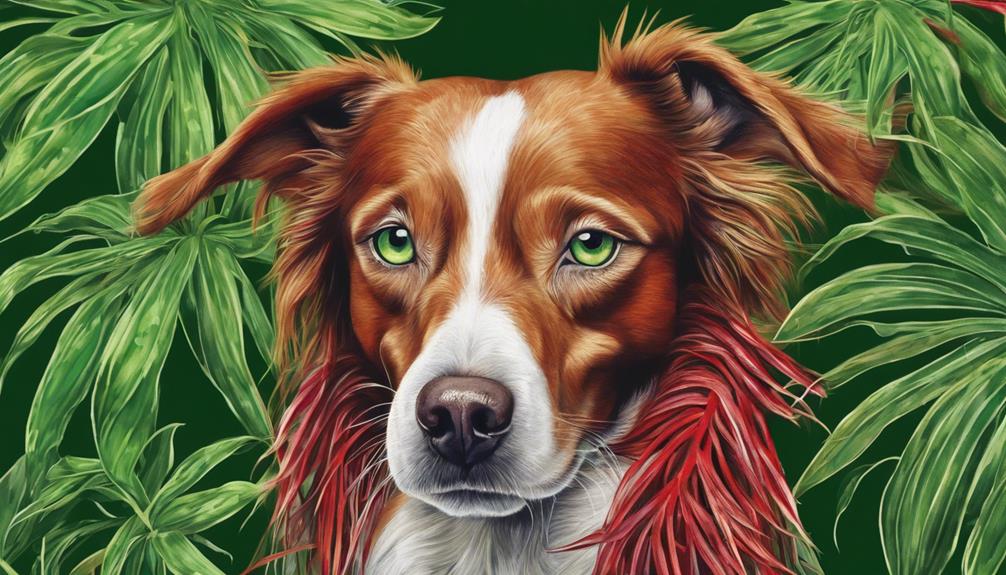
Cordyline plants, like Ti or Hawaiian Ti, are dangerous for dogs due to toxic compounds such as saponins found in all parts. Symptoms of ingestion include vomiting, weakness, and dilated pupils. If toxicity is suspected, induce vomiting, administer activated charcoal, and seek prompt veterinary care. Diagnosing poisoning involves physical exams, tests, and x-rays. Treatments include medication, fluid therapy, and close monitoring. Berries, leaves, and roots carry varying poison levels. Keep pets away from these plants. Consult a vet immediately if ingestion occurs. Veterinary care is essential for managing cordyline toxicity in dogs effectively. Discover more about protecting your furry friends.
Key Takeaways
- Cordyline plant is toxic to dogs due to saponins in all parts.
- Symptoms include vomiting, weakness, and dilated pupils.
- Emergency actions include inducing vomiting and seeking vet care.
- Prompt veterinary diagnosis and treatment are crucial.
- Keep Cordyline plants out of reach to prevent toxicity.
Cordyline Plant Overview
Investigating the harmful nature of the Cordyline plant reveals its potential dangers to dogs. The Cordyline plant, also known as Ti plant or Hawaiian Ti, is a common decorative plant found in many households and gardens. This plant contains toxic compounds, such as saponins, in all its parts, including the berries and roots. These compounds can be harmful to our canine companions if ingested. Dogs may experience symptoms like loss of muscle control, weakness, and gastrointestinal issues if they consume any part of the Cordyline plant. It's vital for pet owners to be aware of the potential dangers this plant poses to their furry friends.
As responsible pet owners, it's important to make sure that our dogs don't have access to the Cordyline plant to prevent accidental ingestion. By being vigilant and keeping our pets away from this toxic plant, we can protect them from experiencing harmful effects on their health. Remember, prevention is essential when it comes to keeping our furry friends safe from toxic plants like the Cordyline.
Common Symptoms of Toxicity

What're the common symptoms of toxicity in dogs exposed to cordyline plants? Dogs can show various signs of toxicity if they ingest parts of the cordyline plant. Some common symptoms include vomiting, weakness, loss of muscle control, and dilated pupils.
These signs can occur immediately or may be delayed, depending on the amount ingested. The toxic compounds present in cordyline, such as saponins and glycosides, are responsible for these harmful effects on dogs. Saponins and glycosides can lead to serious health issues in our canine friends, so it's essential to be aware of these symptoms if your dog has been near or ingested a cordyline plant.
If you notice any of these signs or suspect cordyline toxicity, seek immediate veterinary attention. Remember, prompt diagnosis and proper treatment are crucial for the recovery of dogs exposed to cordyline toxicity. Keep a close eye on your furry companion and act promptly if you suspect any issues related to plants toxic to dogs.
Emergency Actions to Take
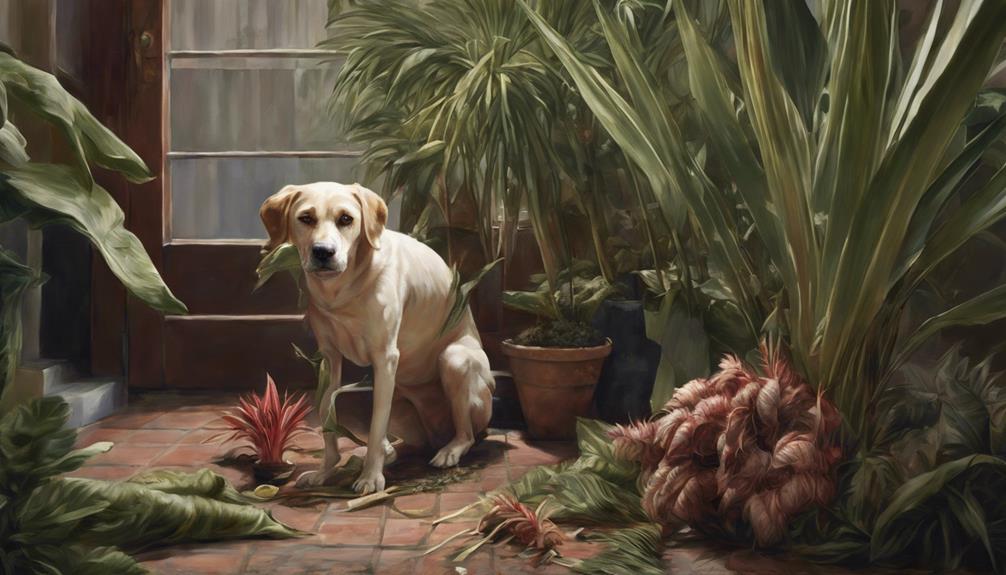
After observing symptoms of cordyline toxicity in dogs, immediate actions can include inducing vomiting to expel the toxic plant material. Administering activated charcoal can help prevent further absorption of toxins. It's important to seek veterinary care promptly. Intravenous fluids might be necessary to flush out the toxins and rehydrate your dog. These steps can aid in the speedy recovery of your pet.
When dealing with a potential cordyline poisoning, remember that quick action is key. Inducing vomiting and giving activated charcoal can limit the harm caused by the toxins. Ensuring your dog receives proper hydration through intravenous fluids will support their healing process. By acting swiftly and decisively, you can increase the chances of a positive outcome for your furry friend. Remember, in emergencies like these, always consult a professional for guidance.
Diagnosing Cordyline Poisoning

To diagnose cordyline poisoning in dogs, veterinarians conduct a thorough physical examination to assess the dog's health parameters. Diagnostic tests such as urine, stool samples, and blood tests may be necessary to confirm cordyline ingestion. X-ray imaging can help detect any tummy blockages caused by ingested plant material in cordyline poisoning cases. Symptoms of cordyline poisoning in dogs may include vomiting blood and weakness, indicating the severity of the toxicity. Here is a table summarizing the diagnostic methods used in cordyline poisoning cases:
| Diagnostic Method | Description |
|---|---|
| Physical Examination | Assess dog's overall health and look for symptoms. |
| Urine Sample Analysis | Check for presence of toxins from ingested plants. |
| Blood Tests | Evaluate blood parameters for signs of toxicity. |
These methods help veterinarians confirm cordyline ingestion and determine the appropriate treatment for the affected dog.
Treatment Options Available

When a dog ingests cordyline and shows symptoms of toxicity, treatment options include:
- Giving medication to counteract the poison
- Providing fluid therapy to flush out toxins and rehydrate the pet
- Closely monitoring essential signs to guarantee improvement
These steps are pivotal in managing the effects of cordyline poisoning and supporting the dog's recovery.
It's essential to seek immediate veterinary care for proper diagnosis and treatment to increase the chances of a successful outcome.
Medication for Poisoning
In treating cordyline toxicity in dogs, activated charcoal may be administered to prevent further absorption of toxins. This helps to bind the toxins in the stomach and intestines, reducing their harmful effects.
Additionally, intravenous (IV) fluids are often given to dogs who've ingested cordyline. These fluids help flush out the toxins from the body and keep the dog hydrated.
Antibiotics may also be prescribed to prevent any infections that could arise from cordyline poisoning.
Moreover, medications like antacids or omeprazole can be used to alleviate stomach issues that may occur due to cordyline toxicity.
Fluid Therapy Options
Utilizing intravenous fluid therapy plays an essential role in supporting dogs affected by cordyline toxicity, aiding in toxin elimination and rehydration. When dealing with cordyline poisoning, administering IV fluids is essential to help flush out the toxins from the body and maintain proper hydration levels. IV fluids not only support organ function but also assist in eliminating toxic substances effectively. By providing fluids intravenously, veterinarians can precisely control the volume and rate of fluid delivery, ensuring the dog receives the necessary support for recovery. Proper fluid therapy helps in maintaining blood pressure, electrolyte balance, and hydration levels, all of which are crucial in the treatment of cordyline toxicity.
| Fluid Therapy Benefits |
|---|
| Supports toxin elimination |
| Aids in rehydration |
| Maintains organ function |
| Controls fluid volume and rate |
| Essential for recovery process |
Monitoring Vital Signs
Evaluating essential signs in dogs affected by cordyline toxicity is pivotal for determining the severity of the poisoning and deciding necessary treatment interventions. Monitoring critical signs such as heart rate, respiratory rate, and temperature is essential in gauging the dog's condition.
Changes in these parameters, along with symptoms like dilated pupils and loss of muscle control, can indicate the seriousness of the toxicity. Veterinarians rely on these signs to measure the effectiveness of treatments and the overall well-being of the dog.
Close observation of important signs guides the treatment plan, ensuring appropriate actions are taken for the dog's recovery. Any abnormalities in essential signs may prompt additional interventions or adjustments to the treatment protocol, emphasizing the importance of continuous monitoring for the dog's health.
Preventing Cordyline Ingestion

To prevent cordyline ingestion in dogs, it's essential to keep these plants out of their reach. Educate yourself on the symptoms of cordyline toxicity to recognize any potential issues early on.
Regularly inspect your surroundings to guarantee the safety of your pets and promptly seek veterinary care if ingestion is suspected.
Dangers of Ingestion
To prevent cordyline ingestion in dogs, it is important for pet owners to be aware of the toxic nature of all parts of the plant and take necessary precautions. Dogs can suffer from cordyline poisoning if they ingest any part of the plant, such as the berries, leaves, or roots. To highlight the dangers of ingestion, consider the following table:
| Part of the Plant | Concentration of Poison |
|---|---|
| Berries | High |
| Leaves | Moderate |
| Roots | High |
Understanding the toxicity levels in different parts of the cordyline plant can help pet owners recognize the seriousness of ingestion. By being informed and vigilant, we can protect our furry friends from the harmful effects of cordyline poisoning.
Safety Measures for Pets
Let's take the necessary steps to safeguard our pets by implementing practical safety measures to prevent cordyline ingestion.
To guarantee your furry friends' well-being, keep cordyline fruticosa plants out of their reach.
Educate yourself on the toxicity levels of these plants for pets.
Consider getting pet insurance to cover emergencies like vomiting blood due to cordyline ingestion.
If you suspect your pet has ingested cordyline, seek veterinary care promptly.
Regularly check your surroundings for cordyline plants to maintain a safe environment for your pets.
Importance of Veterinary Consultation
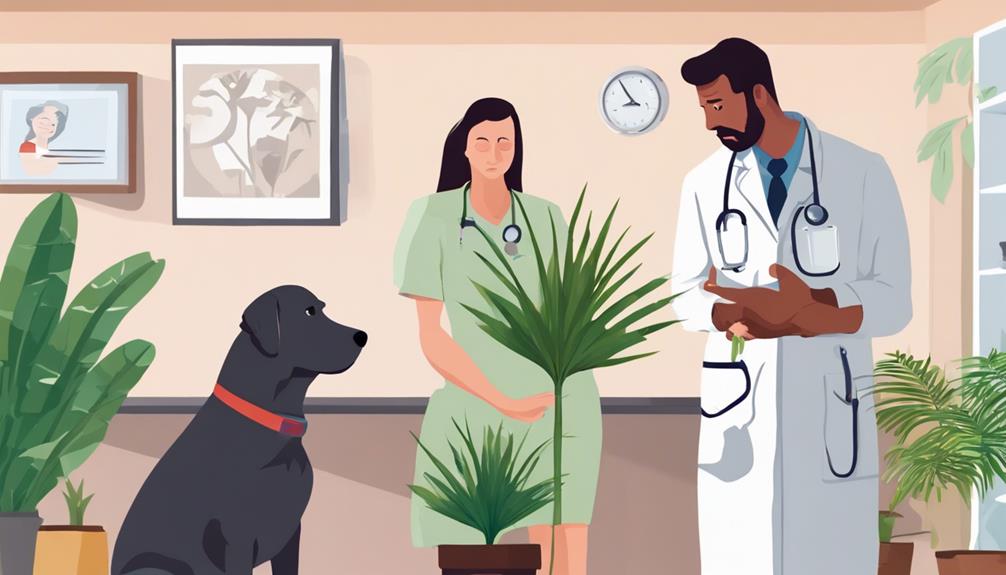
Seeking veterinary consultation promptly is essential when dealing with suspected cordyline toxicity in dogs. When it comes to your furry friend's health, timely action can make a significant difference. Here's why veterinary consultation is pivotal:
- Professional Assessment: Veterinarians have the expertise to evaluate the severity of the situation. They can determine the best course of action to help your dog recover.
- Tailored Treatment: Through veterinary consultation, your pet can receive personalized care. This tailored approach can address specific symptoms and mitigate the effects of cordyline toxicity.
- Prevention of Complications: Acting quickly by consulting a veterinarian can prevent the development of serious complications. Immediate intervention increases the likelihood of a successful recovery for your canine companion.
Frequently Asked Questions
Can Dogs Chew on Ti Leaves?
Yes, dogs shouldn't chew on ti leaves as they're toxic to them. Ingesting ti leaves can cause symptoms like vomiting, diarrhea, and abdominal pain in dogs. The toxic compounds in ti leaves, such as saponins, can lead to serious health issues.
If you suspect your dog has chewed on ti leaves, seek veterinary care immediately for evaluation and treatment. Keep ti plants out of reach of pets to prevent accidental ingestion and toxicity.
Is Cordyline Red Sister Toxic?
Yes, Cordyline Red Sister is toxic to dogs due to saponins present in all parts of the plant. Ingestion can cause vomiting, diarrhea, weakness, and loss of muscle control in dogs. The berries and roots are especially harmful, containing concentrated poison.
Immediate veterinary care is essential if ingestion occurs to avoid severe complications. Treatments may involve induced vomiting, activated charcoal, IV fluids, and organ failure medication.
Is Cordyline Toxic to Humans?
Yes, cordyline plants are harmful to humans. Ingesting parts of the cordyline plant can cause mild symptoms like stomach upset in humans.
The toxic compounds in cordyline affect humans differently than they do dogs. It's important for pet owners to know about cordyline toxicity specifically concerning their dogs.
While cordyline toxicity is a concern for pets, it's not a significant health issue for humans.
Are Cabbage Palms Poisonous to Dogs?
Cabbage palms, or Cordyline plants, are toxic to dogs. Ingesting any part of the plant can cause symptoms like weakness and muscle control loss. Saponins and glycosides are the compounds responsible for this toxicity.
Immediate veterinary attention is vital if ingestion occurs. Symptoms may include vomiting blood, weakness, and abdominal pain. It's important to keep these plants away from pets to prevent any accidental ingestion and potential harm.
Conclusion
To wrap up, it's vital to keep cordyline plants away from your furry friends to prevent potential toxicity. If ingestion occurs, seek immediate veterinary assistance.
Remember, the consequences of cordyline poisoning can be severe, so it's important to take preventative measures seriously. Let's guarantee our pets stay safe and healthy by being vigilant about the plants they come into contact with.
After all, a healthy pet is a happy pet!
Dana is our Lead Content Writer, bringing a wealth of knowledge and expertise to our team. With a background deeply rooted in animal studies and a profound love for all creatures, Dana is dedicated to crafting engaging and informative content that resonates with our audience. With Dana at the helm, you can trust that our content is accurate and engaging, catering to the diverse interests of animal enthusiasts everywhere.
-

 Vetted1 month ago
Vetted1 month ago15 Best Cat Foods for Managing Hyperthyroidism – Vet Approved and Feline Friendly
-

 Cats7 months ago
Cats7 months agoTop 5 Cat Breeders in Arkansas: A Guide
-

 Animal Facts1 month ago
Animal Facts1 month agoSpring Animals: A Guide to Seasonal Wildlife
-

 Vetted1 month ago
Vetted1 month ago15 Best Fresh Dog Food Delivery Services for Your Pup's Health and Happiness
-

 Rabbits2 months ago
Rabbits2 months agoExploring Rabbit Holes: What Do They Look Like?
-

 Vetted1 month ago
Vetted1 month ago15 Best Dog Foods for Kidney Disease – Expert Recommendations for Your Pet's Health
-
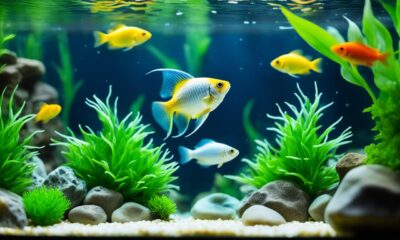
 Fish2 months ago
Fish2 months agoKeeping Your Sucker Fish Thriving at Home
-

 Pets2 months ago
Pets2 months agoLatest Pet Statistics in US – Trends & Insights in 2024



















